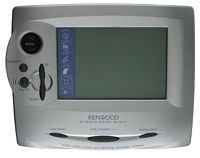Kenwood Sovereign VR-5900 audio/video receiver Page 2
 The VR-5900 offers very basic bass management: when you set it for Small speakers, you get THX's standard 80Hz highpass filter. There are overall system Bass and Treble controls.
The VR-5900 offers very basic bass management: when you set it for Small speakers, you get THX's standard 80Hz highpass filter. There are overall system Bass and Treble controls.
The VR-5900 includes Kenwood's Universal Video feature. This decodes both composite and S-Video sources so that they can be routed to your video display through the component video connection. Video performance was exemplary. As viewed on my Philips 55-inch HD set, high-definition signals were passed through the Kenwood's video switcher without degradation.
Sound
No spatial surprises in the Dolby Digital and DTS departments—today's best receivers are processing monsters equipped with sufficient chip power to handle such activity, and the VR-5900 decoded my usual reference discs as well as any receiver I've encountered. I watched scenes from Terminator 2: Judgment Day, The Haunting, The Fifth Element, and other references, and was satisfied that the Kenwood did them justice. I added a 1980s-vintage Hafler DH-200 to power the rear effects channels for DD EX and DTS ES and the combination worked fine, but for me, these extra channels are about as necessary as feet on a fish. I think Kenwood was smart to omit amplification for those (very) optional channels. Nor did DTS multichannel music discs, including Toy Matinee, The Allman Brothers Band at Fillmore East, or Steely Dan's Gaucho, provide any surprises in the way they handled surround sound.
The VR-5900 was powerful and very dynamic. Playing movie soundtracks, it rocked the house with the best of them, but compared to B&K's AVR-307 ($3498) and my reference Integra DTR 9.1 ($3200), it simply couldn't compete—especially when reproducing music. It lacked the transparency, 3-dimensionality, and overall musical ease of those two competitors, especially with 2-channel music. Though not profound, the differences were easily noticeable through the smooth-as-silk Sonus Faber Grand Piano speaker system I used during the review period. And remember—the competitively priced B&K and the Integra both include seven channels of amplification, and the B&K features sophisticated controls for bass management and "bass bump" room EQ.
I ran the tricked-out 2-channel analog outputs of the Camelot Technology Round Table DVD player (it upconverts 16-bit/4.1kHz CD to 24/96, and has been upgraded to 24/192) into the 2-channel analog inputs of all three receivers. I also ran the 5.1-channel Sony XA-777 SACD player (review in progress) into their 5.1-channel analog pass-through inputs. Both players shone a light on the Kenwood's character: a gray, gauzy overlay that reduced the transparency and liquidity of well-recorded music (especially from 24/96 DADs and SACDs), which the Sonus Fabers can deliver in abundance. It almost sounded as if the VR-5900 was somehow processing the signal, adding a mechanical residue that prevented music from flowing naturally, and from developing harmonically and spatially.
Conclusion
Kenwood's Sovereign VR-5900 is a powerful, well-thought-out, top-shelf audio-video receiver packed with virtually every feature and decoding scheme currently offered (missing only onboard RF demodulation for Dolby Digital laserdiscs). It decodes HDCDs and 24/96 DADs (DVD-based digital audio discs), and ergonomically, it's among the best receivers I've encountered. Its front and rear panels are cleanly laid out and well-labeled. The touchscreen LCD remote, while heavy and requiring two hands and frequent battery changes, is versatile and a pleasure to use, as such devices go. And the setup and operating instructions are the best I've seen from any manufacturer.
If you want full use of EX and ES decoding, you'll have to add an extra 2-channel amplifier, but I actually like that—it keeps the internal power supply from having to juice yet another pair of amplifiers. Five amps is enough for any power supply to handle.
I don't know whether the VR-5900's less than stellar sound, especially in 2-channel mode, is due to Kenwood's D.R.I.V.E. (for Dynamic Resolution, Intensive Vector Enhancement, a software-based means of increasing the effective resolution to 32 bits) or to something else. All I know is, while the KV-5900 performed more than adequately with movies, most of which feature soundtracks that have been heavily processed to begin with, I wouldn't recommend it for a home-theater system doing double duty as a music system—not when, for about the same cost, it is clearly outperformed by other receivers that can pass an analog signal without digital processing.
But if versatility and ease of setup and use are important to you, the Kenwood Sovereign VR-5900 may be your best choice. If you can, you should listen for yourself—you might find the Kenwood's dynamic, powerful sound more than adequate for your home theater.
- Log in or register to post comments






























































